Rebuilding Prohibited Lands
What is a Non-Rebuildable Land?
A "Non-rebuildable land" refers to land where constructing a new building is not possible. Once the building is completely demolished, it literally means that rebuilding is not an option.
The reasons for this can vary depending on the property, but in Kyoto, a common reason is when the land is not facing with the road that meets the minimum requirements specified in the Building Standards Act, particularly if it is less than 2 meters wide.
Similarly, if a property only adjoins an alley or narrow pathway (which is not classified as a road in law), it is generally considered not rebuildable as well.
Kyoto, with its many narrow alleys and a high number of old buildings, has a significant number of properties that fall into the category of not being rebuildable.
4 common examples of Non-Rebuildable Lands
The diagrams below show some common examples of non-rebuildable lands. (Constructions might be possible depending on the conditions of lands similar to the ones shown in the diagram.)
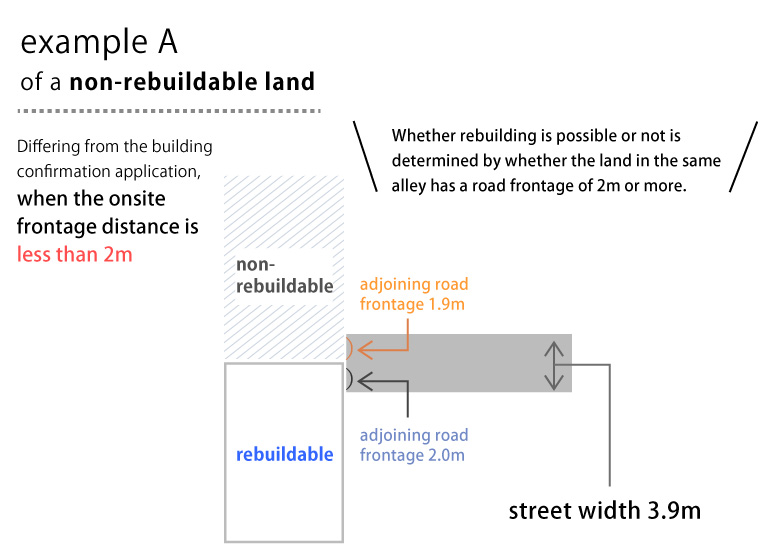
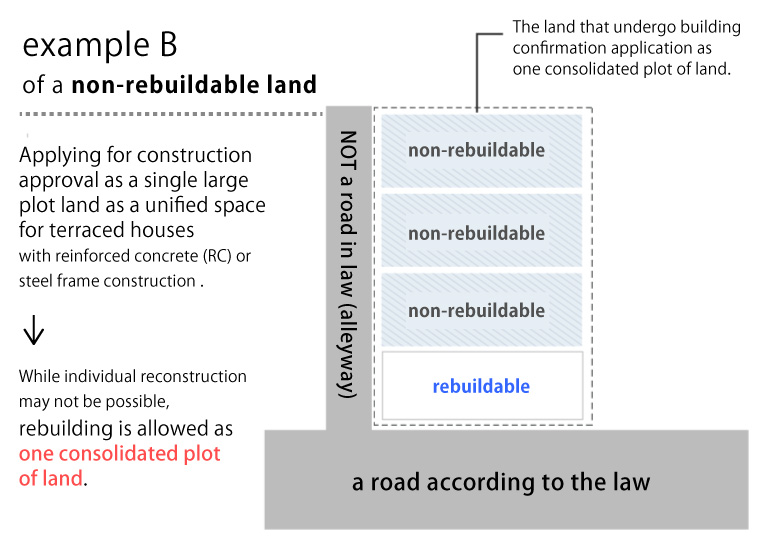
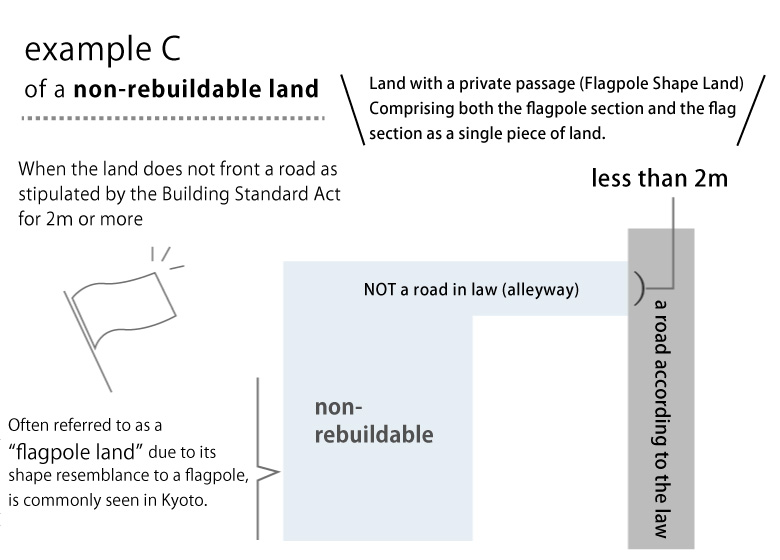
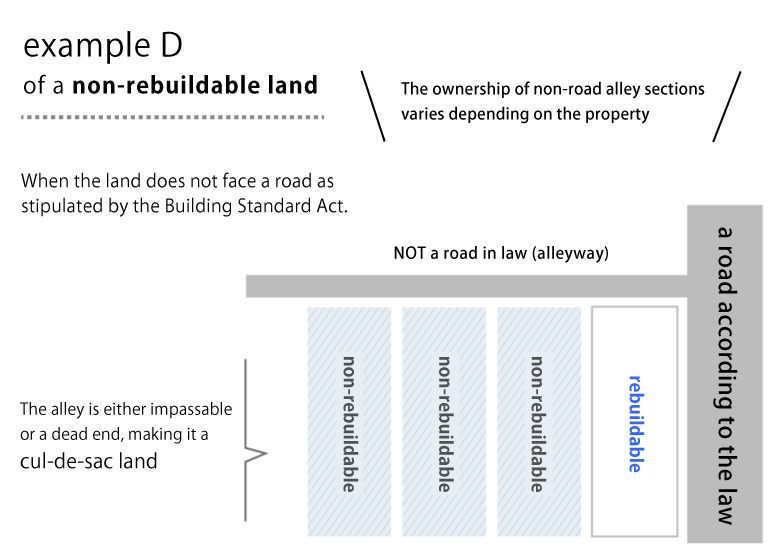
Why are there lands that buildings are non-rebuildable?
If the obligation to have an access road had been fulfilled from the beginning, non-rebuildable properties would not have arisen. Why did such lands come into existence?
This is because they were already in existence before the current laws were established.
The Building Standards Act was enacted in 1950 (25th of Showa era), and the City Planning Act in 1968 (43rd of Showa era). Houses built before 1950 or before being designated in urban planning areas may not have fulfilled the obligation of having an access road.
There are quite many properties that do not meet the access road requirements specified by the Building Standards Act - meaning they only have access to roads that are not recognized as such under the law.
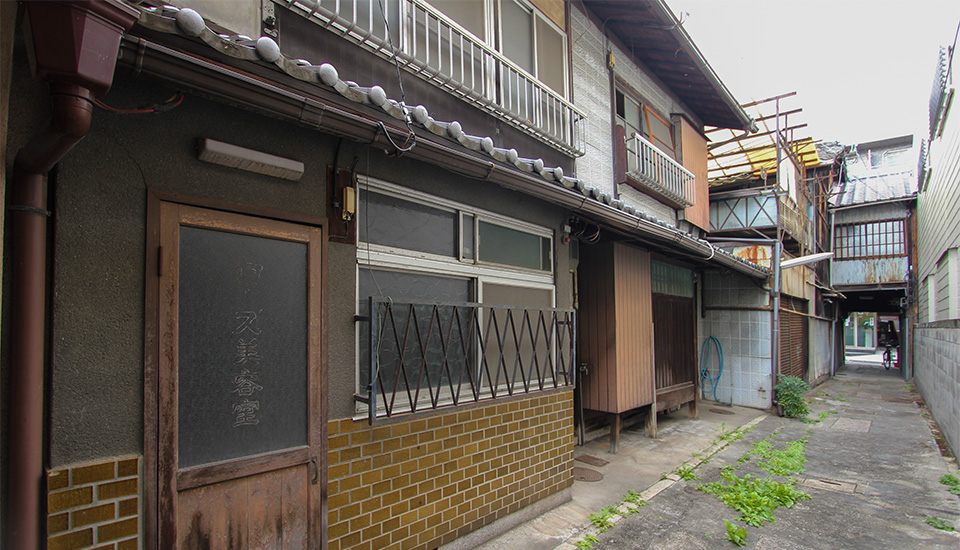
If rebuilding is not possible, some may feel that
"land with no future prospects" or a "property not worth considering or purchasing". Is this perception accurate?
Actually, even if rebuilding is not an option, a property can still serve as a long-term residence through proper renovation and maintenance.
At Hachise, we aim to preserve the cultural heritage of narrow alleys and traditional Kyoto townhouses (Kyomachiyas) by reviving and circulating them. We believe in maintaining the aesthetic appeal and preserving these Kyomachiyas, even if they are labeled as "not rebuildable."
Properties marked as "non rebuildable" may possess various charms when viewed from a different perspective. You might discover a dwelling that perfectly suits your needs.
Pros & Cons of Non-Rebuildable Lands
- ○ Pros
- ○
- Affordability Compared to Rebuildable Properties
- Due to the lower pricing compared to rebuildable properties, it is easier for individuals considering to purchase as post-retirement residences, second houses, or newlyweds.
As an image, the evaluation of land that cannot be rebuilt is typically less than half the market value of a similarly sized plot facing a general road with a width of 4 meters or more. - ○
- Tax Benefits
- Tax benefits are more likely to emerge. Compared to surrounding lands, the evaluation of the land as an asset is lower, resulting in lower assessments for inheritance tax and fixed property tax.
This lower standard evaluation also facilitates cost-effective inheritance and gifts. (Note: Buildings are evaluated for fixed asset tax.) - ○
- Recommendation for Those Seeking Traditional or Retro Residences
- Non-rebuildable properties are mainly those ones built before the enforcement of building standards. If the entire area prohibits reconstruction, the landscape, especially within an alley remains relatively unchanged because rebuilding is not easily achievable.
- ○
- Comparable Rental Yields
- Rental rates are similar to rebuildable properties, resulting in higher returns on investment. The pivotal factor influencing success in real estate investment is the location. Non-rebuildable properties within walking distance of a station are in high demand for investment purposes, potentially securing a high return under favorable conditions.
- ○
- Safe and Quiet Alleyways
- Since vehicles cannot enter, the alleys are considered as safe place. In a calm living environment where cars do not pass (or cannot enter), it is quiet, and there is less risk, providing peace of mind, especially for families with small children who may not face accidents from them running out of the entrance.
- × Cons
- ×
- Low Value as Land
- Compared to typical properties, non-rebuildable properties generally have low collateral value, making it challenging to secure housing loans.
- ×
- Inability to Rebuild After Earthquakes or Fires
- In the event of building collapse due to earthquakes or fires, and a new construction is required, obtaining building permits may be challenging, rendering it impossible to rebuild.
Note: Renovation may be possible if the framework remains - ×
- Resale Value of Non-Rebuildable Properties Depends on Real Estate Companies' Distribution Capabilities
- The resale value (resale price) of non-rebuildable properties is influenced by the distribution capabilities of real estate companies. Real estate companies have areas of expertise and areas where they may not perform as well. This aspect can be challenging to discern from outside the industry. Hachise handles many non-rebuildable properties and will support smooth sales based on the expertise we have developed.
- ×
- Challenges in Repurposing for Special Structures Such as Inns or Shops
- There are hurdles in converting non-rebuildable properties for use as special structures like inns or shops.
Possibility of Constructions on a Non-Rebuildable Land
Even in the case of non-rebuildable properties, there may be the possibility of reconstruction as a "remedial measure."
Regarding Article 43 of the Building Standards Act (Paragraph 2, Item 2):
Originally, the site of a building must "abut a road under the Building Standards Act by at least 2 meters." However, according to the Building Standards Act, "if a specific administrative agency deems it not to impede traffic, safety, disaster prevention, and hygiene based on the surrounding conditions and obtains the approval of the Building Inspection Committee, construction is possible."
In other words, even if the site does not abut a road, it is possible to construct a building under certain conditions if the approval of the Building Inspection Committee is obtained. The criteria for approval vary by municipality, and it is necessary to meet the specified requirements. Confirmation is required for each site.
In principle, the property owner initiates the permit application, and the permit is granted not to the land but to the "construction plan".
You might get a permission by, for example, acquiring adjacent land that abuts a road under the Building Standards Act, it becomes possible to fulfill the access requirements and potentially make reconstruction feasible.
Considering various conditions, it's essential to note that non-rebuildable does not necessarily equate to an unsellable or defective property with no asset value.
